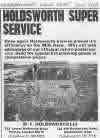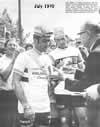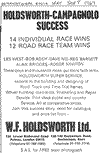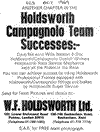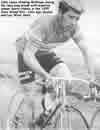For 1963 Bob agreed to join the Hemel Hempstead CC, where Roy similarly supported Mike Shea and Jim Hinds, forming a small team with Bob Addy's father as manager. They were given beautiful copper plate finished Holdsworths. These were made by Reg Collard in the Putney shop. Reg meticulously hand filed every lug, "as a frame-builder he was second to none" (Bob Addy). These frames were probably not any particular model, but bespoke Holdsworths.
In 1964 Jim Hinds left and Mike Brown arrived, a fourth, Alan Perkins joined them later. The squad rode lime green Holdsworth Stradas with white panels and red, lower case, comic/casual lettering. Reg Collard built some frames used in the 1964 Olympics.
In 1965 Bob Addy became an 'Independent' class rider, backed by Falcon, but that year the UCI deemed that Independent riders would be re-classed as professionals. Up until then the 'indies' could race with the amateurs or the pros. They could receive sponsorship and a financial retainer, but were independent of either class. With the UCI reclassification, they had to turn Pro. or take a year out before being reinstated as amateur. In Feb 1966 Bob headed to the South of France, but after an impressive performance in Belgium was signed there in 1966 by Terrot, as a full professional.
In 1966 the British Professional Cycle Racing Association (BPCRA) was formed, Roy Thame became Chairman (a position held for many years) and pro races were organised in the UK. Suddenly there were 70+ UK registered pros, with plenty of teams and events. Optimism in the UK was high, tempting some riders back from the continent. Despite this, the instability and low basic pay for a pro failed to tempt many top amateurs and the annual flow, from amateur to pro in the late 60's /early 70's, was just a trickle.
In Nov/Dec 1966 Bob Addy wanted to return to Britain, he approached Roy Thame who agreed to sponsor him as a UK based pro. This was a shop thing, W.F.Holdsworth, it had nothing to do with the Holdsworthy factory. A special Holdsworth frame was made for Bob by Reg Collard. They adopted the Hemel Hempstead CC colours of orange and blue. The neutral service Austin pick-up usually carried three spare bikes, one was a silver Holdsworth (with red block lettering) in Bob's size (23.5").
Holdsworthy step in
Bob felt he would have to join another team if Holdsworth couldn't sponsor a full squad. Roy approached Dave Goodall, Sales Manager of Holdsworthy, who agreed to help sponsor a team. Holdsworthy were the sole UK importers of many quality brands. Campagnolo agreed to be a main co-sponsor, others like Regina, Fiamme and D'Allesandro agreed to be sub-sponsors. The sponsorship arrangement was that Holdsworthy provided all the cycles, equipment, clothing and cash for bonuses. The shop, W.F. Holdsworth, built the wheels, did all the organising, provided the back-up service and team cars, the first being a 1966 Ford Corsair 2 Litre GT (bought 1969). Roy Thame was the Team Director / manager / masseur and handled all personnel matters. Roy became Chairman of the British Pro. Cycle Racing Assoc. and held that position for many years.1968: Team Formation
| Riders like Les West wanted to stay amateur for the Sept 1968 Olympic Road Race in Mexico City, but immediately afterwards the full Holdsworth-Campagnolo team was formed for the 1969 season. | 
|
| 1969 | Bob Addy | Les West | Roger Newton | Dave Nie | Reg Barnett | Alan Bridges |
Rider Details
Reggie Barnett, a top sprinter, joined from Clive Stuart & left at the end of 1969 to join Falcon.
Alan Bridges worked at Anerly and was backed by the MD Dave Goodall. He was a very able racer, rode a fast 25 mile TT, but struggled at professional level. Despondent after a couple of months he did only local events until the end of the year, when he was replaced by Mike Cowley.
Bike Details
Unfortunately the top frame in the Holdsworthy range (until at least Oct 69) was a tourer, the Fastback Super Mistral, so the first squad was given custom shop frames (based on the Colnago and approved by the riders. RT), made by Reg Collard. Reg was a craftsman, he produced 2-3 frames per week. Sometimes Reg would make them in the shop, other times at his home in Hemel Hempstead. They were enamelled by Broma Art Enamellers of Romford, London, whose orange was always lighter than the factory orange. Initially the Team frame (See Dale's) design was orange with kingfisher blue panels and large white letters, outlined in red. These frames were actually Holdsworth 'Italia range' Professionals. They had little stick-on italia decals on the fork blades (see Professional model page for details). There was no chrome plating on 1969 team bikes (Brod). "The Pro Team riders were usually issued with a new frame each year and their previous frame was re-enamelled and became their training bike or team spare".(RT)
1969 had its "settling in" difficulties, as would be expected.
- It was the first year Roy Thame & HC had a full team to organise.
- For most of the team riders is was their first Pro year.
- It was the first time they rode together as a team.
- There was a big ability difference between some of the riders.
- They could expect little income from bonuses, so pay would be low.
Top UK Team 1970
 It
was clear to Roy Thame and Holdsworthy that the frame position was not
ideal. The team promoted Holdsworthy products, yet the frame was not from
the factory range. Late in 1969 or early 1970 Bob Addy returned from Belgium
with a frame built to ultra close clearances. This feature so impressed
Holdsworthy they decided to adopt it on a new 'Professional' model. Features
of Reg Collard's WF Holdsworth Professional were adopted too, like longer
lug points. The Holdsworthy Professional appeared in 1970, but the team
still used WF Holdsworth Professional's for this year.
It
was clear to Roy Thame and Holdsworthy that the frame position was not
ideal. The team promoted Holdsworthy products, yet the frame was not from
the factory range. Late in 1969 or early 1970 Bob Addy returned from Belgium
with a frame built to ultra close clearances. This feature so impressed
Holdsworthy they decided to adopt it on a new 'Professional' model. Features
of Reg Collard's WF Holdsworth Professional were adopted too, like longer
lug points. The Holdsworthy Professional appeared in 1970, but the team
still used WF Holdsworth Professional's for this year.
1970 frames
had chrome forks and 10" chainstay chrome (Brod).
| 1970 | Bob Addy | Les West | Colin Lewis | Dave Nie | Mike Cowley |
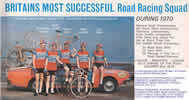 They
raced in the Tour of Majorca, the 5 day Tour of Catalania, etc. Les
West won the British Road Race Championship
with Colin Lewis coming third. In the 1970 Vaux Grand Prix (its final
year, won by Barry Hoban) Colin Lewis came second and Les West third.
They
raced in the Tour of Majorca, the 5 day Tour of Catalania, etc. Les
West won the British Road Race Championship
with Colin Lewis coming third. In the 1970 Vaux Grand Prix (its final
year, won by Barry Hoban) Colin Lewis came second and Les West third.
Les entered the 1970 World Championship, a top one day race being held that year in Leicester. His preparation was far from ideal in August, "with two laps to go he dropped off the back of the bunch to the support car, he said he wanted to pack. After stern words he got back to the bunch. Next minute he was off in a four man break, with Felice Gimondi, that went to the line. We were amazed, he wanted to pack then he's off like a rocket. Les was no sprinter and, although it was close, he came in 4th" (Brod). This was a brilliant result, Les also won the Isle of Wight three day event, the Grand Prix de Nations time trial and other road races, 20 in all. The team had 23 victories, doing well in the Players Tour of the S.W.
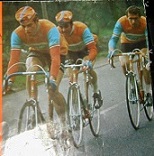 In 1970 Holdsworth-Campagnolo became
the top British racing team. It later became the most successful British
Pro team of all time (Says Ken Denny, pointing out that the excellent
Ti-Raleigh team was Dutch!). After an
In 1970 Holdsworth-Campagnolo became
the top British racing team. It later became the most successful British
Pro team of all time (Says Ken Denny, pointing out that the excellent
Ti-Raleigh team was Dutch!). After an
approach by International Cycle Sport, Les West completed his autobiography 'The
West Way' in Dec 1970. On p51 he pays tribute to Hughie Woods and Kurt Schmidt who 'do all the mechanical jobs for us'.
The team car was often driven by Hughie Woods or Mike Shonleben, Roy Thame's nephew. Mike joined the company in 1971 and was still running the W.F.Holdsworth shop on the Lower Richmond Rd, thirty+ years later. Bob Addy resigned Nov/Dec 1971, said to be over a dispute with Roy regarding tactics. He later rode with some success for Ron Kitching.
| 1972 | Les West | Colin Lewis | Dave Nie | Gary Crewe | Geoff Wiles | Brian Tadman | Peter Kisner |
 Only Les West remained from the original line-up. In 1971 and
1972 Colin Lewis won the teams "Golden Wheel" Award
for being the best all rounder in the squad. Peter Kisner was the
Dutch National Champion 1970.
Only Les West remained from the original line-up. In 1971 and
1972 Colin Lewis won the teams "Golden Wheel" Award
for being the best all rounder in the squad. Peter Kisner was the
Dutch National Champion 1970.
 Gary Crewe was a top sprinter and roadman who promptly repaid Holdsworth
by winning the 1972 BRRC with Les West second. "In that race all
the teams just sat on HC, particularly on Les whose every move was countered.
So Gary went up the road and scored a great victory, Les still came second"
(Brod). After the 1972 season invitations arrived to compete in the prestigious
European Classics.
Gary Crewe was a top sprinter and roadman who promptly repaid Holdsworth
by winning the 1972 BRRC with Les West second. "In that race all
the teams just sat on HC, particularly on Les whose every move was countered.
So Gary went up the road and scored a great victory, Les still came second"
(Brod). After the 1972 season invitations arrived to compete in the prestigious
European Classics.
| 1973 | Les West | Geoff Wiles | Colin Lewis | Gary Crewe | Nigel Dean | Brian Tadman | Peter Kisner |
 |
 |
 |
 |
 |
 |
 |
 |
| Nigel Dean is not shown in this 1973 team pic, though Brod and Ray (and the June '73 pic above) give him in the line-up. Brod left early in 1973 on the Will's Grand Prix (Tour of the West). |
| For the 1973 Tour of Switzerland the composite "Holdsworth-Bantel" team needed eight riders, so Bob Jones was signed as the eighth man. The team was: Sid Barras, Horton, R.Smith, N Dean, C Lewis, G Crewe, L West and Bob Jones. There were two mechanics (Hughie Woods was one), a masseur (Roy Thame) and two team cars. (Belgian pro. Jean Ronsmans stood in too for a race at sometime). Alec Taylor (ex BLRC & NCU Road Race Champion) was employed by the Holdsworthy Co as a representative. He assisted with the team. Alec was a great asset, he was half Belgian and could speak Belge, French, German, Spanish, Italian and was very familiar with continental racing. |
In the 1973 BRRC Les West again came second, after losing a two man sprint finish with Carltons Brian Jolly. New team sub-sponsors were Cinelli, Mavic, Sedis and Clement. At the end of the year, Gary Crewe went to TI Raleigh Euro Team.
| 1974 | Les West | Geoff Wiles | Colin Lewis | Nigel Dean | Keith Lambert | Jock Kerr | Daryl Brassington |
 |
Keith Lambert had turned pro with Falcon in 1972 and stayed for two seasons. After 1973 he moved to Holdsworth, promptly rewarding them with a prestigious win in the 1974 British Road Race Championship (he won it again in 1980, and retired from racing in 1987 after 15 years as a pro). Although Brod left in 1973, he started turning out for HC again in 1974 for major races, like the 1975 Tour of Switzerland. |
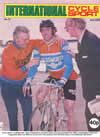 |
|---|---|---|
| 1974 Team |
Les West in 1974
|
|
| The second support car is shown here, a Ford Cortina (Mark 2) 1600E, in team colours. |
on a shop Pro (Brod)
|
|
| 1975 | Les West | Geoff Wiles | Phil Corley | Nigel Dean | Keith Lambert | Jock Kerr | Daryl Brassington |
 |
In 1975 Les West won the BRRC with Keith Lambert second. Colin Lewis retired from racing, with a total of 38 Professional victories to his credit. He set up the Colin Lewis cycle shop (Paignton?) in 1976. By 1976 Bob Addy was reinstated to the amateur class. This brochure (right) is after June 1976, but the pic is 1975.
| 1976 | Les West | Geoff Wiles | Phil Corley | Keith Lambert | Jock Kerr |
 At
the start of the 1976 season Ray Robinson joined as team
mechanic. Nigel Dean had gone, becoming team Captain with Falcon. Geoff
Wiles won the BRRC in June1976 with Phil Corley 3rd.
At
the start of the 1976 season Ray Robinson joined as team
mechanic. Nigel Dean had gone, becoming team Captain with Falcon. Geoff
Wiles won the BRRC in June1976 with Phil Corley 3rd.
Holdsworth-Campagnolo had now won 5 of the last 7 BRRC's, all gruelling road races of over 130 miles, in fact they had won the last 3 on the trot, an unprecedented record.
 The
1974 BRRC was won by Holdsworth Campagnolo team
rider Keith Lambert.
The
1974 BRRC was won by Holdsworth Campagnolo team
rider Keith Lambert.
The 1975 BRRC was won by HC rider Les West
(with Keith Lambert second).
The 1976 BRRC was won by HC rider Geoff Wiles
(with Phil Corley third) .
All riding Holdsworth Professionals. This was a unique hat-trick.
| 1977 | Les West | Geoff Wiles | Phil Corley | Keith Lambert | Jock Kerr | Richard {Sam} Foster |
Les West was a brilliant time trialist. He had a go at the London - Bath - London record. This was about 170 miles. They started about Reading early in the morning, with the idea of getting into (and out of) London before the traffic got heavy. Inside London Les soon dropped the support car (with Ray Robinson as mechanic) and built up a couple of minutes lead. However a motorist jumped a red light and collided with Les, his rear wheel was smashed. Les was unperturbed, he was well known for his laid back attitude to life, but it cost him minutes waiting for the support car and a new bike. He still broke the record.
Geoff Wiles took 3rd in the 1977 BRRC. Some European exploits were:
The team competed in the Pro Tour of Britain and Scottish Milk Race of
1977 and 1978. They rode the Paris-Roubaix in 1977. They entered the Amstel
Gold in Holland. Some Belgian tours, like the Tour of Flanders and the
Tour of Ghent. Also the Tour of Spain.
1978 The Professional frame lost the blue panels, changing to orange with blue lettering. The team vests were a new style too. Two new team cars, both Ford Cortina (Mark 3) estates, echoed the changes. 1978 Pro SL
| 1978 | Les West | Geoff Wiles | Phil Corley | Phil Bayton | Dudley Hayton | Ian Banbury |
 |
 |
 |
 |
 |
 |
 This
1978 team pic was taken on "winter training"
on the Cote D'Azur in Feb 1978. Geoff Wiles stayed in the UK, to recover
from a collision with a car. This was the final Squad.
This
1978 team pic was taken on "winter training"
on the Cote D'Azur in Feb 1978. Geoff Wiles stayed in the UK, to recover
from a collision with a car. This was the final Squad.
Phil Corley won the 1978 BRRC (he was 3rd in 1976). This was the
6th team Holdsworth-Campagnolo victory.
(Colin Lewis's wins in 1967 and 1968 don't count as he joined in 1969)
The cost of running a Pro Team successfully became too much, so the team was disbanded at the end of the 1978 season and Les West retired from racing. There were about 50 licensed pros in Britain, but the economic situation was very difficult, there had been high inflation in the 1970's and now severe industrial unrest. The recession killed advertising budgets. In 1979 the Tour of Britain was gone, by 1980 only three pro. teams remained; Carlton, Falcon and Viking. The low passed but it was the end of the Holdsworth-Campagnolo Pro Team.
Holdsworth sold a lot of bikes on the success of their racing team, for a couple of seasons the team colour scheme was their most popular finish.
Dudley Hayton came in third in the BRRC 1979 and 1980, second in 1985.
Les West joined Holdsworthy as a Sales Rep, it was thought his fame and popularity would guarantee his success, but he was such a nice guy he didn't like to push for orders. Bill Hurlow recalled that Les was absolutely elated when he arrived at Oakfield Rd with his first order, it was for a number of bikes, only to be told that Holdsworth had recently dropped that model! Les moved to BT and worked for 25 years as an Installation Engineer. He retired from competitive cycling in Oct 2010, one month before his 67th birthday, doing a two up time trial of over 25 miles with an average speed of 27mph!
With particular thanks to:
Dick Brodrick, Ray Robinson, Mike Shonleben, Roy Thame, Bob Addy &
Dave Watts,
Dale Brown of Cycles de Oro, Greensboro, N. Carolina... 'Classic
Rendezvous'.
Cycling Weekly, 17 Feb 96 'The Professionals' by Tony Bell
Cycling Weekly, 24 Feb 96 'Boom and Bust' by Tony Bell

